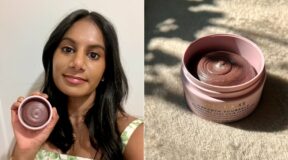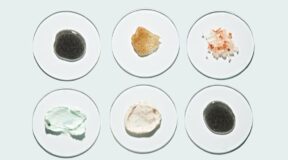Written by Florie Mwanza
Want to wear your natural, afro-textured hair straight without risking heat damage or getting a permanent chemical relaxer? According to the internet, a silk press is the answer to your prayers. Florie Mwanza shares everything you need to know about the process.
Since I first big-chopped over a decade ago, I’ve shaved my head bald (twice), worn my hair in a bleach-blonde short crop, grown huge afros, learned how to make perfect braid partings, and mastered the temperamental twist-out.
Despite how versatile my hair has proven to be and how adept I’ve become at nurturing it, the thought of experimenting with straight styles terrifies me. And who could blame me? For people with natural afro hair, achieving sleek, straight locks is only possible one of two ways: by either using a chemical relaxer, or high heat to straighten out the curled and coiled strands.
With chemical relaxers being permanent, heat straightening is the next best option, and according to social media, a silk press is the way to go. This temporary treatment is so popular, it’s currently a breakout search on Google Trends, has over 3 million posts on Instagram and the silk press hashtag on TikTok boasts around 325 million views.
Although the treatment involves high heat, Kash Bishop, hairstylist at Neville Hair and Beauty in Kensington, assures me that there’s a very low risk of heat damage when done right. I haven’t seen myself with sheet-straight hair since I had a relaxer over 10 years ago, so I jumped at the chance to rock sleek locks again.
Given the fact that I had many questions I needed answering before fully committing, I’m sure you do too. Below, find answers to all your silk press FAQs.
How does a silk press differ from a chemical relaxer?
When a chemical relaxer is applied to natural hair it lifts the hair cuticle, penetrates the cortex and breaks the bonds that make it curly, to leave it permanently straight. In comparison, a silk press is essentially a very thorough process of flat-ironing. The temporary straightening effect lasts only as long as you “keep your hair away from water, steam or sweat, as moisture will cause it to revert back to its natural curl,” says Bishop.
What happens during a silk press?
Using Keracare’s three-step thermal wonder system – which is designed for silk press treatments – Bishop pre-’pooed my hair with the conditioner, washed it out with the moisturising shampoo, and then applied the sealing heat protectant to my towel-dried hair.
According to the hairstylist, “The real MVP of a great silk press is moisture.” Because I have low-porosity hair that’s resistant to soaking up the hydration it desperately needs, during the pre-poo step I sat under a hooded dryer for 20 minutes to encourage my cuticles to open up and absorb the treatment.
Once the heat protectant is sprayed on, there’s no need to apply a leave-in conditioner as you normally would. This is because the heat protectant “seals the cuticles, making hair easier to detangle, as well as protecting it from heat,” Bishop explains.
What sets a silk press apart from regular hair straightening, is that high heat is applied to small sections of hair using slow passes – leaving no hair untouched. My hair was blow-dried in tiny sections on a high heat, with a paddle brush used to further detangle. After blow drying, the hair stylist took small sections of hair and straightened them using a very specific method; he made three slow passes to straighten my roots, and then using a fine tooth comb to separate the strands, he made two slow passes down the length of each section. The treatment ended with a trim and a quick styling session.
How long does a silk press last?
One of the reasons I’m resistant to heat-styling my hair is because the rewards are so short-lived. Although I loved the results of my silk press, I found myself constantly monitoring whether my roots were reverting – and was tempted to straighten them when they started curling back up five days in.
Bishop says: “The average silk press can last between seven to 10 days depending on how active you are in your daily life.” That makes it a great option if you want to change your look for a few days, but an impractical one if you intend to break a sweat during that time.
To keep the hair sleek and in place, the Bishop advises: “Lay off adding excessive product as it’ll weigh the hair down; avoid using any heat when styling; wrap your hair in a silk scarf each night to keep it protected.” I don’t know how to wrap my hair, so pin-curled it in large sections instead, and the bouncy curls masked my poofy roots perfectly.
How often should you get a silk press?
According to Bishop, “Adding heat to textured hair too frequently can cause irreversible damage to the curl pattern. Taking two to three-month breaks between silk presses allows the hair to maintain its integrity.”
Can you silk press your own hair?
As long as you have the right products and don’t use excessive heat, a silk press is easy to attempt at home. But, Bishop warns: “Only a professional hair stylist can accurately detect heat damage. Going to a professional will guarantee you get the style without playing trial and error with the health of your hair.”
Images: Florie Mwanza.
Source: Read Full Article





